| |
|
 | |
| MaltaWildPlants.com by Stephen Mifsud |

|
| |
|
|
 |  |  |  |
| External Links: |
|
Scrophularia auriculata (Water Figwort) |
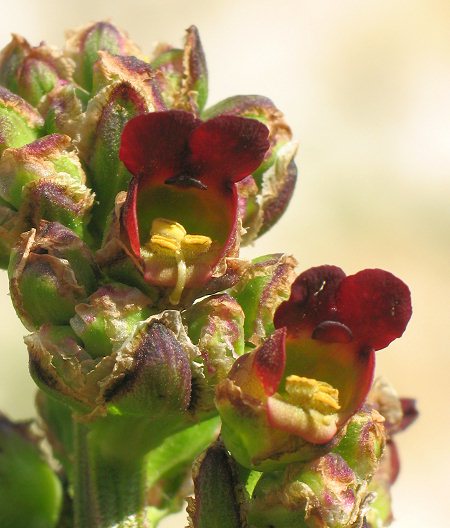
Scrophularia auriculata (SCROPHULARIACEAE.)
Images for this profile are taken from the Maltese Islands after year 2000. |
|
| Nomenclature |
Species name : | Scrophularia auriculata L. | Authority : | Carl von Linne, Sweden, (1707 - 1778) | Synonyms :
(basionym or principal syn.) |
|
Plant Family : | | English name(s) : | Water Figwort, Water Betony, Bishop's Leaves | Maltese name(s) : | Fiswet il-kelb tal-ilma, Werqet il-Madonna | Status for Malta : | Indigenous. Present on the Maltese islands before man | Name Derivation : |
Scrophularia: Named in 1474 by an Italian physician who noticed the resemblance between the rhizomal knobs of some species and the tubercular condition of human lymph nodes called scrophula. Scrofula is a form of tuberculosis affecting the lymph nodes, especially of the neck, that is most common in children and is usually spread by unpasteurized milk from infected cows. (Latin origin ); 2 = Named in 1474 by an Italian physician who noticed the resemblance between the rhizomal knobs of some species and the tubercular condition of human lymph nodes called scrophula. Scrofula is a form of tuberculosis affecting the lymph nodes, especially of the neck, that is most common in children and is usually spread by unpasteurized milk from infected cows.
auriculata: 1 = Ear shaped, referring to the rounded lobes of the upper petals of the corolla. (Latin).
| Remarks : | . |
|
| Morphology and structure |
PLANT STRUCTURE: |
Character | Growth Form | Branching | Surface |
Description | | | |
General
Picture |  |  |  |
|
LEAVES: |
Character | Arrangement | Attachment | Venation |
Description | | | |
General
Picture |  | 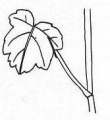 |  |
| |
Character | Leaf Shape | Leaf Margin | Remarks |
Description | | | Stem Stem is rectangular with the 4 corners extending out into short (1mm c.) wings. |
General
Picture |  | 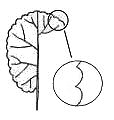 |  |
|
FLOWERS: |
Character | Colour | Basic Flower Type | No. of Petals | No. of Sepals |
Description | Dark red | | 5 Fused at more than half of their length into a tubular globose (helmet-like) structure. | 5 Fused at about their basal third of their length. Margin scarious. |
General
Picture | | 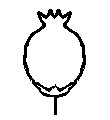 |  |  |
| |
Character | Inflorescence | Description | Ovary | Stamens |
Description | | The flower is made up of 5 petals most of their length fused into a spherical tube and the upper part free as rounded lobes. The mouth of the corolla is wide and without a constricting neck, sometimes described as helmet-shaped. | | |
General
Picture |  |  | 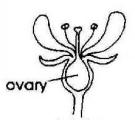 |  |
| |
Character | Scent | Average Flower Size | Pollen Colour | Other Notes |
Description | None or mildly unpleasant | 8mm x 5mm Length of tube (including upper lobes) x diameter of tube. | Pale Yellow | Staminode Apart from the 4 fertile stamens at the lower part of the corolla, there is an extra dark brown, sterile stamen called staminode located just below the upper lips. |
|
SEEDS: |
Character | No. Per Fruit | Shape | Size | Colour |
Description | More than 100 | Small rounded bodies | Less than 1mm | Dark Brown |
General
Picture |  |  |  |  |
|
FRUIT AND OTHER BOTANICAL DATA: |
Character | Fruit Type | Colour of Fruit | Subterranean Parts | Other Notes |
Description | | Green (Pale brown when mature). | | Plant Scent The plant gives of a rather foetid smell, somehow similar to Ballota nigra. |
General
Picture | 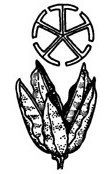 |  | 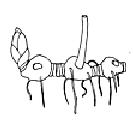 |  |
|
|
| Plant description and characters | |
Life Cycle: | Perennial. |
Growth Form: | HEMICRYPTOPHYTE (prostate plants with flowers close to the ground) |
Habitat: | Damp habitats and valleys close to arable land. |
Frequency: | Very Rare |
Localities in Malta: | Only one location known which will remain undisclosed to protect the plant. |
Plant Height: | 50-100cm. |
| Feb-May |
Protection in Malta: | Protected by law: Schedule III of [S.L. 549.44] (Conservation requires the designation of SAC) |
Red List 1989: | Threatened status for the Maltese Islands and has been listed in the Red Data Book (1st ed.) |
Poison: | |
This herbaceous, mildly foetid plant is found in damp places or often beside water courses. It is perennial thanks to its underground, non-nodular rhizomes which are able to survive hot and arid summer climates. The plant forms numerous fibrous large roots.
The green (or reddish,) glabrous to scarcely puberuluos, hollowed stem grows between 50 up to 150cm high. It has a four-angled cross section, with the corners stretching out into a wing or flap running along the whole length of the stem.
The glabrous, petiolated leaves are lanceolate (sometimes oval) in shape with a rather truncate base and blunt tip. They are arranged opposite along the stems, and often new sub-branches or inflorescences are formed from their axils. They have a crenate to shallowly serrate margin, and branched pinnate venation. Basal leaves can grow around 18cm long or more (including the petiole).
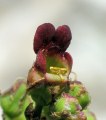 The flowers are arranged in groups of few-flowered, simple cymes which collectively can be defined as a pannicle. Flowers have short pedicels with glandular hairs. The light green, actinomorphic calyx is composed of 5, short (3mm) rounded sepals, fused at their basal third. The zygomorphic corolla is made up of 5 petals which most of their lenght is fused together to form a spherical tube, and their upper part is free into small rounded lobes. The upper pair of lobes are erect, rounded and distinctly larger from the others being like a pair of 'ears' hence the epithet 'auriculata'. These have a contrasting dark-red to wine colour. The 2 lateral lobes are erect small, and the lower lobe is the smallest, green (or yellow) and curved back. The flowers produce very sweet, viscous nectar in abundant quantities at the base of the petals. The flowers are arranged in groups of few-flowered, simple cymes which collectively can be defined as a pannicle. Flowers have short pedicels with glandular hairs. The light green, actinomorphic calyx is composed of 5, short (3mm) rounded sepals, fused at their basal third. The zygomorphic corolla is made up of 5 petals which most of their lenght is fused together to form a spherical tube, and their upper part is free into small rounded lobes. The upper pair of lobes are erect, rounded and distinctly larger from the others being like a pair of 'ears' hence the epithet 'auriculata'. These have a contrasting dark-red to wine colour. The 2 lateral lobes are erect small, and the lower lobe is the smallest, green (or yellow) and curved back. The flowers produce very sweet, viscous nectar in abundant quantities at the base of the petals.
The reproductive part of the flowers consists of 4 stamens more or less of equal length and joined at the base of the lateral and lower petals. Each stamen is composed of a robust hairy filament and a pale, swollen, fertile anther. There is another sterile stamen (staminode) fused at the base of the upper petal which is red in colour with a swollen bifid apex. The pistil is mad of a green, rounded ovary and thin and rather inconspicuous style and stigma, often protruding out from the corolla by few mm.
The fruit is a green, dehiscent capsule, about 1cm across, which when ripe, it turns brown and splits open into 2 valves. It holds numerous tiny, brown seeds (less than 1 mm in size) which escapes from the open fruit by the swaying of the tall plant. Seed dispersion is further aided by insects and possibly carriage by water streams.
|
|
| Information, uses and other details |
Nativity and distribution
The distributional range of this plant is shown in the list below: [WWW-26]
Northern Africa: Algeria (n.), Morocco, Tunisia
Europe: Portugal - Azores, Canary Islands, Ireland, United Kingdom, Belgium, Germany, Netherlands, Switzerland, Greece - Crete, Italy (incl. Sardinia, Sicily), Crete, Italy (incl. Sardinia & Sicily), Spain (incl. Baleares)
Reference [WWW-158] states that S. auriculata is present in the following European countries:
Azores, Belgium and Luxemberg, Balearic Islands, Britain, Corsica, Crete, France, Germany, Ireland, Switzerland, Holland, Spain, Italy, Portugal, Sardinia, Sicily.
Propagation
Sow seeds in spring or autumn in a cold frame [238] . When they are large enough to handle, prick the seedlings out into individual pots and plant them out in the summer.
If you have sufficient seed then it can be sown outdoors in situ in the autumn or the spring. [KF]
Division in spring. Larger divisions can be planted out direct into their permanent positions. We have found it best to pot up the smaller divisions and grow them on in a lightly shaded position in a cold frame, planting them out once they are well established in the summer. Succeeds in most moist soils. [KF]
Bee plant
Wasps and bees are very fond of the flowers, from which they collect much honey. [WWW-03] It is also described as a good bee plant [4] . At the base of each flower there is a viscous droplet of nectar [SM]
Edible Uses
Reference [2, 105] states that the root can be cooked and eaten, however, [KF] doubts about the edibility of the root of this plant.
Medicinal Uses
The plant has the following medicinal properties according to reference: [WWW-66] .
| Anodyne |
Used to relieve pain. [WWW-32] |
| Anti-cancer |
Used in the treatment of cancer; "anticancer drug"; "an antineoplastic effect". [WWW-32] |
| Depurative |
An agent which is able of Purifying the blood or the humors (body fluids) [WWW-32] |
| Detergent |
A medicine used to cleanse wounds, ulcers,
etc. [WWW-32] |
| Diuretic |
Tending to increase the secretion and discharge of urine. [WWW-32] |
| Anti-inflammatory |
An agent that reduces or counteracts inflammation [WWW-32]
|
| Narcotic |
Causes dulling of consciousness, and hence induces sleep rapidly [271] |
| Scrofula |
Acts against the disease called Scrofula - a constitutional disease, generally hereditary, especially manifested by chronic enlargement and cheesy degeneration of the lymphatic glands, particularly those of the neck, and
marked by a tendency to the development of chronic intractable inflammations of the skin, mucous membrane, bones, joints, and other parts, and by a diminution in the power of resistance to disease or injury and the capacity for recovery. Scrofula is now generally held to be tuberculous in character, and may develop into general or local tuberculosis
(consumption). [WWW-32] |
| Vulnerary |
Useful in healing wounds; adapted to the cure of external
injuries; [WWW-32] |
The leaves of the plant have vulnerary and detergent properties and have been used in folk medicine as a poultice for ulcers, sores and wounds. [WWW-27]
The leaves are detergent and vulnerary [4] . They are harvested as the plant comes into flower and can be used fresh or dried for later use [4] . The plant has a good reputation as a wound herb, either applied externally as a poultice or taken as a decoction [4] .
Water betony is said to have similar medicinal properties to the knotted figwort, Scrophularia nodosa [254] . These properties are as follows:-
Knotted figwort is a plant that supports detoxification of the body and it may be used as a treatment for various kinds of skin disorders [254] .
The whole plant is alterative, anodyne, anti-inflammatory, diuretic, mildly purgative and stimulant [4, 9, 21, 165] .
It is harvested as the plant comes into flower in the summer and can be dried for later use [4] .
A decoction is applied externally to sprains, swellings, burns, inflammations etc, and is said to be useful in treating chronic skin diseases, scrofulous sores and gangrene [4, 254] . The leaves can also be applied fresh or be made into an ointment [4] .
Internally, the plant is used in the treatment of chronic skin diseases (such as eczema, psoriasis and pruritis), mastitis, swollen lymph nodes and poor circulation [238] .
It should not be prescribed for patients with heart conditions [238] .
The root is anthelmintic [9] .
This plant has vulnerary and detergent properties, and has enjoyed some fame as a vulnerary, both when used externally and when taken in decoction. In modern herbal medicine, the leaves are employed externally as a poultice, or boiled in lard as an ointment for ulcers, piles, scrofulous glands in the neck, sores and wounds. It is said to have been one of the ingredients in Count Matthei's noted remedy, 'AntiScrofuloso.' [WWW-03]
In former days this herb was relied on for the cure of toothache and for expelling nightmare. It has also a reputation as a cosmetic, old herbalists telling us that:
'the juice or distilled water of the leaves is good for bruises, whether inward or outward, as also to bathe the face and hands spotted or blemished or discoloured by sun burning.' [WWW-03]
Toxicity
Few sources on the internet mention that the plant is believed to bu toxid, without giving more details. One reference [76] states that the plant is toxic to cows. Another source [WWW-125] states that Scrophularia auriculata (also called water betony or Water Figwort) probably contain toxic cardiac glycosides; causes excitement, tachypnea, pupillary dilatation, oral mucosal congestion and ulceration, dysuria and profuse diarrhea.
Curiosities related to the names of the plant.
The Figwort is named in Somersetshire, 'Crowdy Kit' (the word kit meaning a fiddle), or 'Fiddlewood,' because if two of the stalks are rubbed together, they make a noise like the scraping of the bow on violin strings, owing no doubt to the winged angles. In Devonshire, also, the plant is known as 'Fiddler.' [WWW-03]
The Water Figwort has obtained the name of Water Betony from a certain resemblance of its leaves to those of the Wood Betony, but it differs entirely from that plant in every other respect, not being even closely related to it, and nowadays is more generally called the Water Figwort, the name Figwort being derived from the form of the root in another member of the genus Scrophularia, the Knotted Figwort (S. nodosa), a fairly common plant. [WWW-03]
Proposal to conserve the name Scrophularia auriculata (Scrophulariaceae) with a conserved type
Two of the moisture-loving Scrophularia species
have been known as S. lyrata Willd. and S. auriculata L.
The differences between the two taxa, which were
assessed by Grau (in Mitt. Bot. Staatssamml. Munchen
12: 622-627. 1976), and reiterated by Ortega-Olivencia
& Devesa (in Ruizia 11: 52. 1993), are to be found above
all in the morphology of leaves, bracts, bracteoles, and
staminode. The former, S. lyrata, includes plants which
are often pubescent, with basal and medial leaves clearly
lyrate, having 2-6 lateral lobules; bracts and bracteoles
normally obovate and obtuse, with a broad, undulate,
generally dark-purple scarious margin; and staminode
orbicular or obovate (never more broad than long). It
possesses 2n = 58 chromosomes, and is distributed
through the Iberian Peninsula, Sardinia, Sicily, Crete,
Morocco, and Algeria. The latter, S. auriculata, includes
plants which are often glabrescent, with basal and medial
leaves that are generally simple or with 1-2 basal lobules;
bracts and bracteoles generally lanceolate and
acute, with a narrow scarious margin frequently relegated
to the apex, barely or not at all undulate, normally
hyaline or greyish-brown; and staminode generally
broader than long, subreniform or flabellate. It possesses
2n = 84 chromosomes, and is present in W and SW
Europe, Corsica, Italy, and Morocco. [403]
A New Iridoid from Scrophularia auriculata ssp. pseudoauriculata
A new iridoid glycoside, scrovalentinoside (1), was isolated from the MeOH extract of the aerial parts of Scrophularia auriculata L. ssp. pseudoauriculata. The structure of the new compound 1 was elucidated as 6-O-(2'',3''-di-O-acetyl-4''-O-p-methoxy-cinnamoyl)--L-rhamnopyranosyl catalpol by spectroscopic methods. The known iridoid glycoside, scropolioside A; two saponins, verbascosaponin A and verbascosaponin; and the phenylethanoid glycoside, verbascoside, were also isolated. [400]
Anti-inflammatory glycoterpenoids from Scrophularia auriculata
The activity of the four glycoterpenoids: two saponins, verbascosaponin A and verbascosaponin, and two iridoids, scropolioside A and scrovalentinoside, isolated from Scrophularia auriculata ssp. pseudoauriculata, were studied in different models of acute and chronic inflammation. Both saponins significantly inhibited the mouse paw edema induced by carrageenan and ear edema induced by single and multiple doses of 12-O-tetradecanoylphorbol 13-acetate (TPA). Verbascosaponin A showed a potency twice as high as that of indomethacin in the acute TPA model. Verbascosaponin A and scropolioside A were active after a long latency period against ethyl phenylpropiolate edema, as are glucocorticoids. When the putative corticoid-like mechanism of the two compounds was studied, verbascosaponin A activity was notably reduced by the mRNA synthesis inhibitor, actinomycin D, while the effect of scropolioside A was partially interfered with by the anti-glucocorticoid drugs used. Both iridoids were active on the delayed type hypersensitivity reaction. They significantly reduced the inflammatory lesion and suppressed the cellular infiltration. [401]
Closely Related species
Another damp-loving Scrophularia species which resembles Scrophularia auriculata L. is Scrophularia lyrata Willd., a species that it is not recorded on the Maltese Islands. On contrast to S. auriculata, S. lyrata is pubescent, has more compound leaves that is lyrate with 2-6 lobes each, more obtuse bracts (obovate shape) with undulate margins, and an orbicular or obovate staminode which is never more broad than long. [403]
Personal Observations
Closely Related species in Malta
The much more common Scrophularia peregrina, is often found in arable land or wasteground beside arable land, but seldom in damp habitats. It can be distinguished from S. auriculata by being smaller, having unwinged stems and non scarious sepals. S. auriculata is a very rare plant, possibly facing extintion due to loss of habitat and so one should not damage, cut or tamper with this plant. [SM]
|
|
| Links & Further literature
(0 papers) |

Google Web |

Google Images |

Google Scholar |

Research Gate |

Wikipedia |

JSTOR |
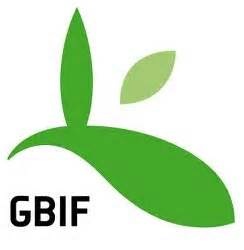
GBIF |

Med Checklist |
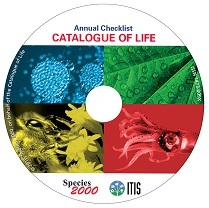
Cat. of Life |

EoL |

IPNI |

World Flora Online |

Plants of the World Online |

Vienna Virt. Herb. |

RBGE Herbarium |

KEW Herbarium |

MNHN |

Arkive |

IUCN |

CABI |
Kindly Email if there are papers and publications about local
studies or information about this species to be included in the list above.
|
| Photo Gallery (28 Images) |  |
 |
 |
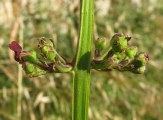 |
IMAGE: SCRAU-01 Photo of inflorescence which is often very tall, reaching about 50cm and sometimes more. |
IMAGE: SCRAU-02 Photo of inflorescence, where flowers are borne in two groups at opposite sides of stem. |
IMAGE: SCRAU-03 Photo of flowers and buds at the apex of the inflorescence. |
IMAGE: SCRAU-04 Photo of the inflorescence, a compact group of pedicelate flowers growing at opposite sides of the 4-sided stem. |
 |
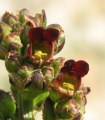 |
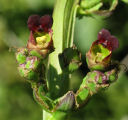 |
 |
IMAGE: SCRAU-05 Photo of flower group which consists of a linear bract, some 8-18 flowers with thick, glandular pedicels that are longer than the calyx. |
IMAGE: SCRAU-06 Photo of two flowers. The mouth of the corolla tube is rather wide; not constricting to a narrow neck. The reproductive organs are hence well accessible by pollinators of different sizes. |
IMAGE: SCRAU-07 Photo of 2 flowers each composed of 5 petals which are fused together at the base to form a sub-spherical tube. The upper part the petals are free forming small lobes, of which the upper pair of lobes are the largest and erect, while the lower is the smallest and curved down. |
IMAGE: SCRAU-08 Photo of the mouth of the flower showing the different forms of the corolla lobes. |
 |
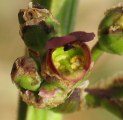 |
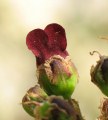 |
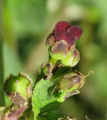 |
IMAGE: SCRAU-09 Photo of flower (front view) showing the large, sterile, reddish stamen at the roof of the corolla, a pair of large, fertile, yellow stamens below and a thin down-pointing style at the bottom (floor) of the corolla opening. The style is few mm longer from the stamens. |
IMAGE: SCRAU-10 Another photo showing a close up of the flower mouth, with the reproductive organs inside. The yellow stamens have thick filaments. |
IMAGE: SCRAU-11 Photo of the dorsal (back) part of the flower. It has 2 large, rounded lobes which resembles a pair of ears, hence the species name 'auriculata' (= ears). |
IMAGE: SCRAU-12 Another photos showing the upper, rounded lobes of the corolla. |
 |
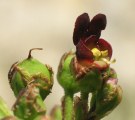 |
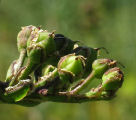 |
 |
IMAGE: SCRAU-13 Photo of flower against light showing well the sterile, dark red, stamen pair - fused into one body. This sterile stamen (pair) is referred to as the staminode. |
IMAGE: SCRAU-14 Photo of the flower and the fruit - a green rounded capsule. |
IMAGE: SCRAU-15 Photo of inmature fruit and calyces. The calyx is composed of 5 sepals with a scarious margin - an important identification characteristic for this species to be distinguished from other Scophilaria members which do not have scarious margins. |
IMAGE: SCRAU-16 Photo showing the paper wasp pollinating the flower. The flower offers good supply of nectar. |
 |
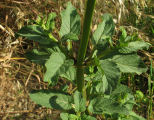 |
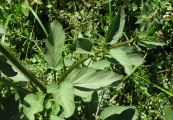 |
 |
IMAGE: SCRAU-17 Photo of leaves in situ. They are shortly petiolated and arranged in opposite directions along the stem. |
IMAGE: SCRAU-18 Photo of leaves having prominent, pinnately-branched, sunken venation. |
IMAGE: SCRAU-19 Another photo of the leaves that are in the range of 5-15cm long. |
IMAGE: SCRAU-20 Ovate to elliptical shaped leaves with a sub-cordate base (sometime truncate) and a crenate margin. |
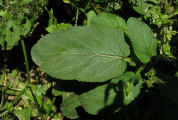 |
 |
 |
 |
IMAGE: SCRAU-21 Photo of lower leaves which are broadly ovate. Upper leaves are narrower (elliptical shape). |
IMAGE: SCRAU-22 Photo of the perennial plant which grows around 100cm, but can reach up to 180cm in fertile soil with good water supply. |
IMAGE: SCRAU-23 Photo of plant growing close to a valley bed, the preferred habitat of this species in Malta. |
IMAGE: SCRAU-24 Another photo of the plant. |
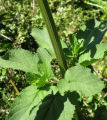 |
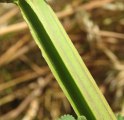 |
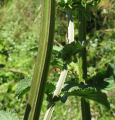 |
| IMAGE: SCRAU-25 Photo of leaves and stem. |
IMAGE: SCRAU-26 Photo of the 4-sided stem with pronounced wings at the corners that extend out by at least 1mm. |
IMAGE: SCRAU-27 Photo showing the wings at the corners of the stem. |
IMAGE: SCRAU-28 - |
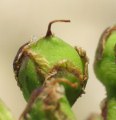 |
| | | IMAGE: SCRAU-29 Photo of a young fruit capsule. When mature it turns brown and the tiny seeds are released by the swaying of the plant, which might be further dispersed by ants or water streams. |
IMAGE: SCRAU-30 |
IMAGE: SCRAU-31 |
IMAGE: SCRAU-32 |
|
| | |

